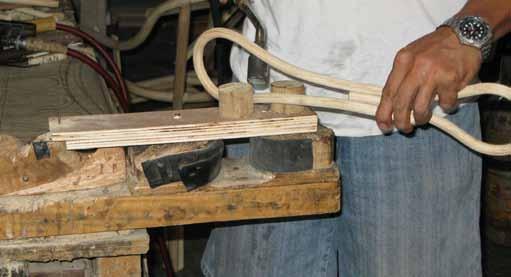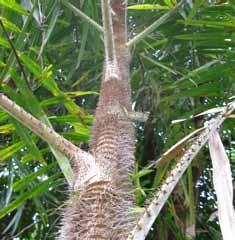
5 minute read
OPPORTUNITIES AND CONSTRAINTS
1.4 Opportunities and Constraints in the Plantation Wood Value Chain
Many POs had undertaken tree plantation establishment activities within the island of Leyte. The EnRD Program has been assisting 30 POs in the provinces of Leyte and Southern Leyte. All of the POs have established, and were in fact already nurturing mature tree plantations. Most of them were in the process of securing RUP while some were currently engaged in harvesting activities.
Advertisement
Constraints
POs mentioned several constraints that they encountered in tree plantation establishment, management, harvesting, transporting,
and marketing of wood products. Considered as most significant constraints were the following: (1) difficulties in obtaining/securing permits to harvest and transport their forest products; (2) no technology/ lack of equipment/ no capital for furniture processing; (3) limited number of buyers controlling the price of wood; (4) lack of information of buyers and traders regarding the marketing of products; and (5) the poor quality of plantation grown timber that makes them difficult to process into furniture.
POs claim that they lack linkages to and information on other potential buyers. For marketing they are mostly dependent upon
buyers recommended to them by CENRO personnel. Often, these buyers offer to buy timber at very low prices. This situation leaves POs with no choice in terms of where they could get the best returns for their plantation timber.
Opportunities
Traders and processors are aware of the increasing availability of timber from Gmelina and Mahogany, and they view this as a
welcome opportunity for the sub-sector. The sustained demand for wood components needed for furniture, housing, construction, and for SPWPs is also seen as an opportunity by this group of stakeholders. On the side of constraints, the group feels that the value chain is adversely affected by the declining furniture market, the lack of product development, the lack of quality materials from species traditionally used for furniture, and the lack of information on uses of wood species other than narra and lauan.
A number of POs recognize their potential to succeed in tree
plantation development. This assessment can be attributed to the following:; (1) interest shown by some local and national development institutions to financially support the POs in their tree plantation establishment activities (e.g. PNOC-EDC is currently implementing tree planting programs in partnership with POs within their area of jurisdiction); (2) the vacant and open areas available for tree plantation expansion; (3) interest by the POs to engage in furniture making using their plantation timber for income generation by selling to schools and even churches; and (4) ability of POs to replant in previously harvested areas.

Expansion of the DENR information system. A possible solution, according to Mangaoang and co-workers (2006), is the expansion of the DENR information system that is already in place in CENRO Maasin, Southern Leyte, to cover the entire Leyte Island, if not the whole region. Enabling the POs to adopt and participate in the timber market information system would result in a better price for timber/lumber as it would allow farmers to access as many potential buyers as possible.
The creation of a federation of POs may also help open up
opportunities to improve the disposition and marketing of forest
products from CBFM areas. As a group, the federation can try to influence the DENR to simplify the permitting and marketing system of the POs’ products. Another possible responsibility of the federation is to oversee the local and regional market for timber and other finished products. The federation can help link the POs with different local and domestic buyers of timber. A PO federation would also be in a better position to initiate liaison and create partnerships with local and national development institutions that can provide assistance in improving the POs’ performance and delivery of their functions along the plantation wood value chain.
POs engaged in Gmelina production have yet to overcome biases and perceptions that the wood of Gmelina is of
poor quality. There are some consumers who think that Gmelina wood is fit only for low-cost scaffolding material that can be substituted for coco lumber when the latter is in short supply, and for other low-value products. Box 03 below explains the issues involved in harvesting and processing Gmelina timber and how the perceived defects in quality and working properties, which result in the poor image of the species, could be overcome.
Many of the opportunities and constraints identified by the value chain operators were also confirmed by the enablers, which had a longer list than the real actors in the chain. Enablers contradicted the traders and processors in their assessment of the availability of updated product development and design.
The group also believes that current policies encourage more planting of trees, not to mention availability of funds, seedlings, technology and areas for planting. They also think that Leyteños have the skills required to promote the value chain. But constraints to the value chain exceeded the opportunities. They view farmers as indifferent to quality requirements, using very little or no good practices to ensure quality of logs, sustainable planting, maintenance, and harvesting. Farmers were also seen as lacking in skills to access funding for plantation establishment.
Enablers also deride the unharmonized policies that result in difficult and cumbersome permitting process and other hidden transaction costs associated with harvesting plantation timber. On the processing and marketing aspects of the chain, enablers consider as constraints the inefficient lumber process technology in use which results in poor quality products. This would make it more difficult for the local industry to compete with imported products that are viewed as cheaper apart from being better in quality and design. The marketing system is considered as largely unsynchronized, making the industry prone to unfair trade practices and market price distortion. The enablers also wondered why some furniture makers still prefer “banned” species as their raw materials.
» annEx f: ThE SUmmaRY of ThE oPPoRTUnITIES anD ConSTRaInTS IDEnTIfIED bY STaKEhoLDERS Who PaRTICIPaTED In ThE VaLUE ChaIn VaLIDaTIon WoRKShoP ThE DIffEREnT





